
Coloring sheets provited by NASA.
- Subject:
- Physical Science
- Material Type:
- Activity/Lab
- Provider:
- NASA
- Provider Set:
- STEM Outreach
- Author:
- NASA
- National Aeronautics and Space Administration
- Date Added:
- 01/30/2023

Coloring sheets provited by NASA.
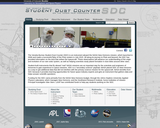
This is a lesson about density. Learners will relate the concept of density to the density of dust in space. They will use mission data from the Student Dust Counter (SDC) interface to determine the density of dust grains in a volume of space in the Solar System in order to answer questions concerning the distribution of dust in the solar system. They will discover that space is much more sparsely populated with dust than they may have thought. Students discuss their findings with the class.

This is a lesson about using light to identify the composition of an object. Learners will use a spectrograph to gather data about light sources. Using the data they’ve collected, students are able to make comparisons between different light sources and make conjectures about the composition of a mystery light source. The activity is part of Project Spectra, a science and engineering program for middle-high school students, focusing on how light is used to explore the Solar System.

This article discusses an example of a practical use of the square root of 2 by explaining how this irrational number figures in printing two pages on one side of A series-sized paper. This resource is from PUMAS - Practical Uses of Math and Science - a collection of brief examples created by scientists and engineers showing how math and science topics taught in K-12 classes have real world applications.

In a mechanical demonstration of the Pythagorean theorem, this example provides a practical, hands-on method for deriving square roots using a carpenter's square. This resource is from PUMAS - Practical Uses of Math and Science - a collection of brief examples created by scientists and engineers showing how math and science topics taught in K-12 classes have real world applications.

This is a lesson about detecting atmospheres of planets. Learners will explore stellar occultation events (by interpreting light curves) to determine if an imaginary dwarf planet “Snorkzat” has an atmosphere. The activity is part of Project Spectra, a science and engineering program for middle-high school students, focusing on how light is used to explore the Solar System.

This is an activity about star movement due to the Earth's rotation. Learners will utilize the Sky Tonight online program to find the star that appears stationary in our night sky. They will then draw conclusions about the Earth’s rotation based on the position changes of certain stars. This activity requires the use of a computer with Internet access. This activity is Sky Tonight Activity 2 in a larger resource, Space Update.

Students participating in Storm Signals play a critical role in the overall process of the Student Observation Network (S.O.N.). They are able to confirm the predictions of the Sunspotter's Sunspot Suspect, and they will predict magnetic storms around Earth, issuing Space Weather alerts that tell other students to begin monitoring the Magnetosphere for magnetic storms. By collecting and analyzing real-time data from their radio antennas, professional observatories, and NASA satellites, they can carry out the same duties as NASA researchers! The Space Weather alerts issued by the Space Environment Center (SEC) of NOAA (National Oceanographic and Atmospheric Administration) are essential to protect satellites, power grids and astronauts.
In Storm Signals you will learn:
1. How to instruct students in the construction of a simple device to detect radio emissions from the Sun.
2. How to enable students to obtain and interpret radio emissions from ground-based professional observatories.
3. How to enable students to obtain and interpret radio, x-ray and ultraviolet emissions from NASA satellites.
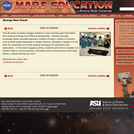
This activity is about the use of remote sensing in planetary exploration. Learners will find out how human curiosity in planetary exploration results in science questions, engineering solutions, and teamwork. This activity demonstrates how planetary features are discovered by the use of remote-sensing techniques. Students will experience the different phases in planetary exploration, including telescope observations, fly by missions, orbiters, landers, rovers, and their own ideas about human exploration. The lesson models scientific inquiry using the 5E instructional model and includes teacher notes, prerequisite concepts and vocabulary.
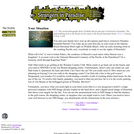
This activity introduces students to what a digital image is and how it relates to the real world. It involves a simple training exercise on making linear and area measurements using NIH Image software. The activity is part of Exploring the Environment.
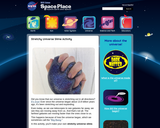
In this activity, you'll make your own stretchy universe slime.

The Sunspotters program of the Student Observation Network (SON) is excellent for grades K +12. There are activities for all grades available. You or your students may think of other questions to investigate that can lead to open inquiry by using live and archived data. By collecting and analyzing real-time data from student telescopes, professional observatories, and NASA satellites, they can carry out the same duties as NASA researchers!
In Sunspotters you will learn:
How to instruct students in the construction and use of simple solar telescopes to observe sunspots and to predict which sunspots are most likely to produce solar flares or coronal mass ejections,
How to enable students to obtain and interpret data from ground-based professional observatories,
How to enable students to obtain and interpret data from NASA satellites.
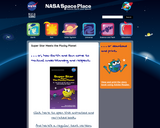
This is an animated and narrated storybook about the Sun and its effects on Earth. Learners will read or hear about characteristics of the Sun and Earth that influence their interaction. Topics touched upon include star sizes, star life cycle, stellar core nuclear processes, plasma, solar flares, coronal mass ejections, solar wind, electromagnetic spectrum, Earth’s magnetosphere, and electromagnetic energy.
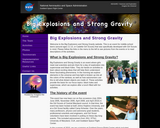
In this activity, students are reminded that the Universe is made up of elements and that the heavier elements are created inside of a star, as they learned in the "Elements and You" activity. They are introduced to the life cycle of a star and to the way in which a star's mass affects its process of fusion and eventual death. Students discuss the physical concept of equilibrium as a balancing of forces and observe an experiment to demonstrate what happens to a soda can when the interior and exterior forces are not in equilibrium. An analogy is made between this experiment and core collapse in stars, to show the importance of maintaining equilibrium in stars. Finally, students participate in an activity which demonstrates how mass is ejected from a collapsed star in a supernova explosion, thereby dispersing heavier elements throughout the Universe. This activity is part of a series that has been designed specifically for use with Girl Scouts, but the activities can be used in other settings. Most of the materials are inexpensive or easily found. It is recommended that a leader with astronomy knowledge lead the activities, or at least be available to answer questions, whenever possible.
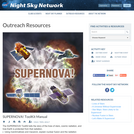
This toolkit includes PowerPoints and scripts, videos and accompanying activities and handouts about supernovae. Following are specific items in the kit: Supernova in the Lives of Stars PowerPoint and Script; Let's Make a Supernova (participants imagine themselves inside a large star at the end of its life, just as it is about to go supernova); Nuclear Fusion (a simple and engaging activity explains nuclear fusion and how radiation is generated by stars, using marshmallows as a model); Supernova Star Maps (allow visitors to experience finding stars in the night sky that will eventually go supernova); A Universe Without Supernovae (an active game to illustrate the value of supernovae in the universe); and Lives of Stars (an activity and handout about the lifecycle of stars and when supernovae happen.)

This activity builds the basic understanding that the heating (indicated by temperature differences) of an object is related to the object’s surface color. Materials required for this investigation include a pair of thermometers, light and dark construction paper, a heat lamp, and two foam cups and two large containers. The resource includes teaching tips and questions to guide student discussion. This is chapter 3 of Meteorology: An Educator's Resource for Inquiry-Based Learning for Grades 5-9. The guide includes a discussion of learning science, the use of inquiry in the classroom, instructions for making simple weather instruments, and more than 20 weather investigations ranging from teacher-centered to guided and open inquiry investigations.
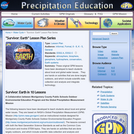
This series of ten lessons has been developed to teach students about local and global water issues. They are based on NASA’s Global Precipitation Measurement (GPM) Mission. The activities are done largely outdoors and include scientific data collection and analysis and integrate technology. Many of the lessons involve data collected based on protocols from the GLOBE Program. Each lesson is designed to take one hour; the lessons build on each other, but can also be used independently. Each lesson topic includes a lesson plan, PowerPoint presentation, student capture sheet and capture sheet answer guide.

This is a model for students to assemble, aimed at enhancing their knowledge of NASA spacecraft and scientific facts. The cover contains background information about the Thermosphere, Ionosphere, Mesosphere Energetics and Dynamics (TIMED) mission as well as two language arts activities to reinforce space science vocabulary and concepts.
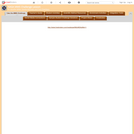
This is a challenge-based activity set designed to have students explore and research the Magnetospheric MultiScale Mission (MMS). Students will explore the purpose and relevance of the mission as well as the scientific methodologies. Activities include application of the scientific method, problem solving strategies, research, collaboration, critical thinking and communication. Links to resources and appropriate web 2.0 tools are provided through a shared livebinder.

Dancing Lights: Exploring the Aurora through Art and Writing is a science-in-literacy program about the aurora. Students in grades 3-5 write and illustrate their perceptions, ideas, and facts pertaining to auroral science. This short educator background primer was based upon interactions with teachers during Dancing Lights workshops and is meant as a quick guide to the science of the aurora.